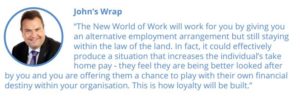I am back with some further extractions from my previous book ‘The New World of Work’ and some more thoughts on how we can build & manage employee’s personal branding. At that time the book and its contents were looking to the future but now, due to COVID-19 perhaps it’s looking at the present…
What does an ‘Engaged Employee’ look like?
“Engaged employees” work with passion and feel a profound connection to their company. They drive innovation and move the organisation forward. Engaged employees make up only 18% of the Australian workforce and 64% of the New Zealand workforce.
What does a ‘Not-Engaged Employee’ look like?
“Not-Engaged Employees” are essential “checked-out”. They’re sleepwalking through their workday putting time in however no energy or passion in their work. “Not-Engaged Employees” make up 61% of the Australian workforce and 64% of the New Zealand workforce.
How much does having Disengaged Employees cost businesses?
Disengaged employees are more likely to leave and take less pride in their workplace. They are also less likely to be advocates of their workplace or the products and services they represent. This obviously comes to a significant cost to Australian businesses. In fact, the Gallup Organisation estimates that actively disengaged employees cost Australian businesses between AUS $33.5-$42.1 billion per annum and New Zealand businesses around NZ $5.6-5.96 billion per annum.
What are the ‘key drivers’ of employee engagement?
There are four contributors to employee engagement. All need to work in harmony to create a powerful relationship with employees.
- Career aspirations – a personally rewarding or major achievement
- Career opportunities – sees a future opportunity, growth and advancement
- Recognition – perceptions of favourable acknowledgement from others for their work/ accomplishments
- Brand – consistency between the promise an organisation makes to its employees about working at that organisation and the work experience
Key Chapter Takeaways:
- Offer Workplace Flexibility
- Flexible hours and generous telework policies are even more important to younger workers than a salary.
- To keep employees around for more than a year, give them the chance to adjust their schedules when the situation calls for it.
- Communicate the company’s mission and values
- Employees want to work at a company whose values match their own.
- If applicants know what they’re signing up for when they pursue positions at your company, the ones who would leave due to value differences.
- Think about outsourcing differently
- Manage contractors or your full-time team via a third party and reduce your overheads.
- Handle workers flexibility and portability through a third party, taking away the nightmare of workers’ compensation and professional indemnity.
- Encourage employer brand loyalty by making use of salary management services that allow your people to take home more without additional business costs.
- Bring the right people aboard – locate the right candidate globally and let a third-party handle the rest. – J. Meister

Next week I will share with you the Four F’s of the New Working Class: Fearless, Freedom, Flexible and Futurist. Meanwhile, please have a look at The New World of Work book… Do you think it’s still true? I would love to know your thoughts…
If you would like to discuss further, please don’t hesitate to contact us…
John Glover, Managing Director, Pendragon
